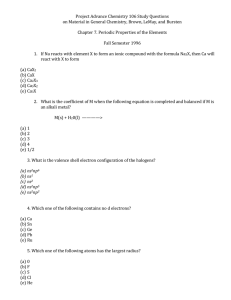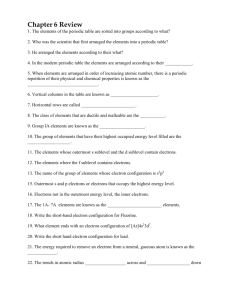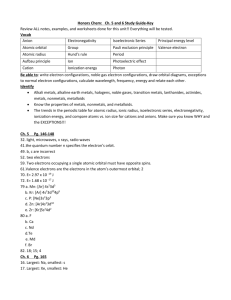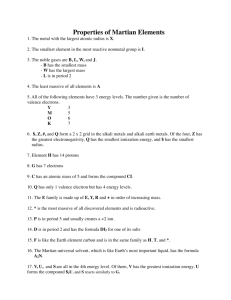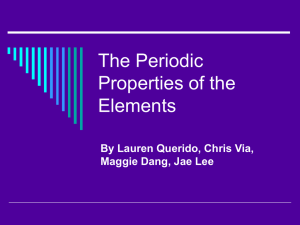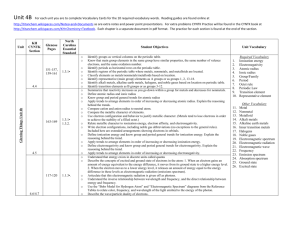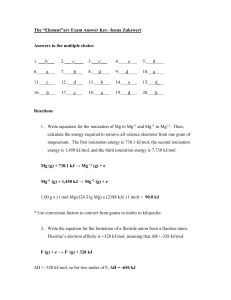Text Questions
advertisement
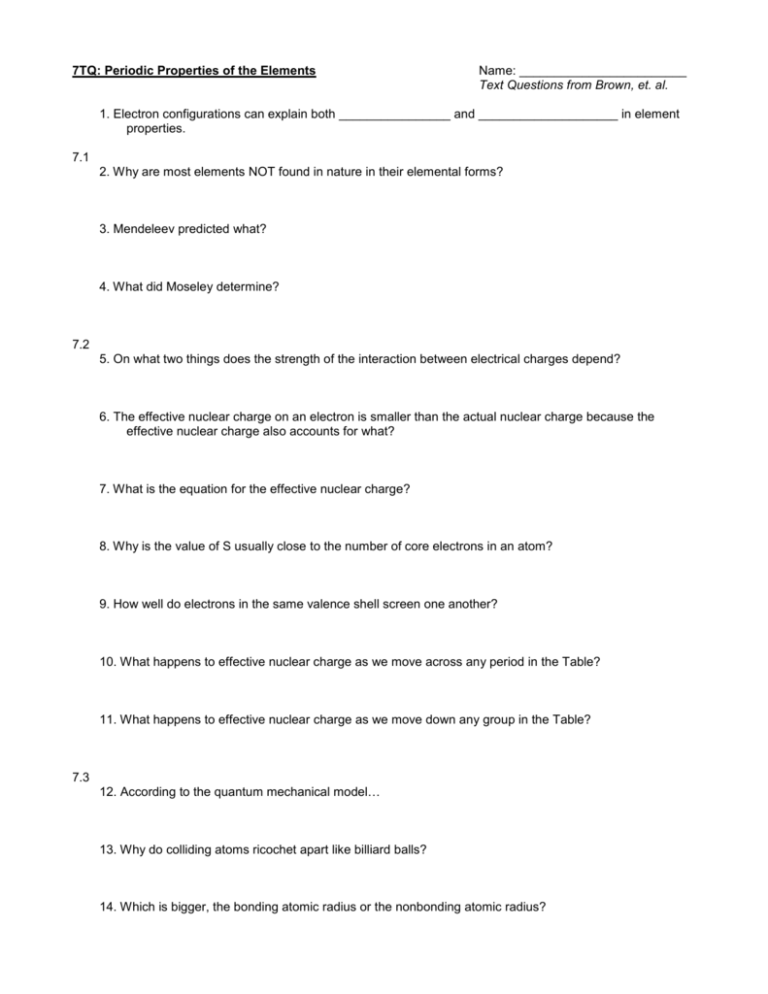
7TQ: Periodic Properties of the Elements Name: ________________________ Text Questions from Brown, et. al. 1. Electron configurations can explain both ________________ and ____________________ in element properties. 7.1 2. Why are most elements NOT found in nature in their elemental forms? 3. Mendeleev predicted what? 4. What did Moseley determine? 7.2 5. On what two things does the strength of the interaction between electrical charges depend? 6. The effective nuclear charge on an electron is smaller than the actual nuclear charge because the effective nuclear charge also accounts for what? 7. What is the equation for the effective nuclear charge? 8. Why is the value of S usually close to the number of core electrons in an atom? 9. How well do electrons in the same valence shell screen one another? 10. What happens to effective nuclear charge as we move across any period in the Table? 11. What happens to effective nuclear charge as we move down any group in the Table? 7.3 12. According to the quantum mechanical model… 13. Why do colliding atoms ricochet apart like billiard balls? 14. Which is bigger, the bonding atomic radius or the nonbonding atomic radius? 15. If we know atomic radii, we can estimate what? 16. Within a group, why does the atomic radius increase from top to bottom? 17. As we go left to right across a period, why does the atomic radius decrease? 18. List two reasons cations are smaller than their parent atoms. 19. Why are anions larger than their parent atoms? 20. What is an isoelectronic series? 7.4 21. The greater the ionization energy… 22. Why are subsequent ionization energies higher than earlier ones? 23. What observation supports the idea that only the outermost electrons are involved in bonding? 24. From left to right across a period, the 1st ionization energy generally ____________. From top to bottom down a group, the 1st ionization energy generally _____________. 25. Smaller atoms generally have ____________ ionization energies. 26. When cations are formed, from which orbitals are electrons first removed? 27. If there is more than one occupied subshell for a given value of n, electrons are first removed from… 7.5 28. What does a positive value for ionization energy mean? 29. Define electron affinity. 30. Ionization energy measures the ease with which an atom ______ an electron, whereas electron affinity measures the ease with which an atom ______ an electron. 31. With argon, for example, the electron affinity is a positive number. What does this mean? 7.6 32. On the Periodic Table, in which two directions does the metallic character of elements increase? 33. List the properties of metals. 34. Why are metals oxidized when they undergo chemical reactions? 35. What is one characteristic feature of the transition metals? 36. Ionic substances are formed from the combination between… 37. Metal oxides are basic because they dissolve in water to form… 38. Metal oxides react with acids to form what? 39. Molecular substances are typically composed of what? 40. Nonmetal oxides dissolve in water to form what? 41. Nonmetal oxides react with bases to form what? 7.7 42. Alkali metals lose how many electrons, forming ions with what charge? 43. What is the formula for the hydride ion? 44. With the exception of lithium, the alkali metals react with oxygen to form what? 45. What do alkali metals emit when placed in a flame? 46. Why are the alkaline earth elements less reactive than the alkalis? 7.8 47. The interiors of Jupiter and Saturn are believed to consist of what? 48. With what does hydrogen react to form solid metal hydrides? 49. Although people usually say “oxygen” when they mean O 2, what term is more descriptive? 50. What are allotropes? 51. What are the formulas for the peroxide ion and the superoxide ion? 52. Even though sulfur consists of S8 rings, why do we usually write it as S(s) in chemical equations? 53. Why is astatine NOT considered to be a halogen? 54. The chemistry of the halogens is dominated by their tendency to do what? 55. What does the term monatomic mean?

